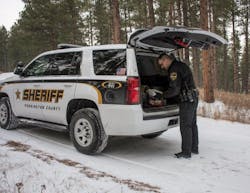Is Your Patrol Car Ready for Winter? Are You?
Preparing fleet vehicles can differ according to department jurisdiction. Agencies located in suburban areas are able to rely on city snow removal equipment in order to make their streets safer to travel on. Clear streets along with the implementation of automatic road condition adjustments in newer fleet vehicles have made preparing units for winter much easier. Winterizing fleet vehicles may differ between rural and suburban departments, but each agency has the same goal in mind when it comes to winter preparation.
For departments in rural counties winterization means not necessarily preparing the vehicle itself for winter, but rather making sure the officer has essential equipment necessary for survival in cold weather conditions. The Pennington County Sheriffs Department in Rapids City, South Dakota, begins packing their units with snow survival gear around the end of October or early November. “We equip our officers with winter gear that will help them survive if they were stuck for 24 hours,” says Captain Jay Evenson of the Pennington County Sheriffs’ Department. Each vehicle is packed with a heavy sleeping bag, food, water, a snowsuit, a shovel, and emergency supplies. The department has had to make use of these supplies during a harsh blizzard where one of their deputies was stranded for hours with five civilians. Evenson says a few years ago a deputy was on route to rescuing car filled with civilians whom were unable to travel due to hazardous road conditions. Though the deputy was able to reach the passengers, the storm became worse forcing the deputy and the civilians to camp out in the unit. “They had to wait a whole night until we could get rescue vehicles out to them,” says Evenson. Since the unit already had extra food, water, and blankets, they were able to survive the night.
Every department has their particular protocol for preparing their police units for the winter months. Often the type of groundwork is dependent upon how clear the streets are during snow and ice storms. In Madison, Wisconsin, the roadways are fairly clear since it is a suburban area. The fleet managers for the Madison City Police Department do not need to do much in order to prepare their units for the winter months. For this department the majority of their winterization preparation is conducting a check on each vehicle, the units tires, the tire tread, and ensuring there are chains in the car if need be. Ron Janowski, Fleet Operations Manager of the City of Madison, says that the improved all wheel drive technology in patrol cars has helped cut down on the amount of winterization preparation that is needed. “Traction and handling are much improved,” says Janowski.
Motor vehicle companies such as General Motors and Ford have developed police units with advanced technology when it comes to traction detection. Additionally, tire companies such as Goodyear and others have developed both winter tires and multi-seasonal tires that also provide a high level of traction. Goodyear offers snow tires that are equal to the size of their all-season tire. Having a snow tire on the unit gives the vehicle an added amount of traction. Changing all four tires to winter tires if necessary and filling each tire to the manufacturer’s air pressure requirement is vital. “This can provide more stability and traction while driving over snow, sleet, and ice,” says Dana Hammer, Manager of Law Enforcement Vehicles, of General Motors, Fleet and Commercial.
Goodyear Tire and Rubber Company has developed the Eagle Ultra Grip GW-3 winter performance tire. Doug Grassian, Senior Manager, Brand Communications of Goodyear says the tire is ideal for police pursuit. The tire has responsive handling and traction capability.
Fleet vehicles such as the Chevy Tahoe PPV, offer options such as all-weather floormats, snow tires and a block heater. “The block heater, which heats the vehicle’s engine, keeps the engine block warm, making starting the vehicle easier in colder temperatures,” says Hammer. The block heater can also shorten the amount of time it takes to warm up the inside of the unit. Hammer says fleet managers can prepare their police cars for winter by taking into a consideration numerous aspects of the vehicle such as making a checklist of items to take care of such as conducting a visual inspection of the batteries ensuring they are secure and the electrical connections are clean.
John Latner, an ASE-certified master technician and training manager for ACDelco, suggests testing batteries that are more than three years old. Taking care of the battery ahead of time will bring peace of mind to the officer assigned to the unit. Having a battery that is working properly will lower the chance of having a failing battery later. During the winter months in particular, being prepared is crucial.
Brakes should also be inspected. Hammer points out if brake components need to be replaced, use fleet brake parts only. General Motors offers a particular line of ACDelco Professional brake items that are engineered and tested specifically for law enforcement. Cooling systems should be inspected to make sure there are no leaks and the reservoir is filled to the correct level for cold weather. Washer fluid should be refilled and oil levels are accurate. Before the winter season oil and filter changes should be scheduled if needed. Checking each vehicle’s engine air filter for dirt or replacement is also recommended. Wiper blades should be inspected and replaced at this time if they are worn or damaged. Finally, it is important that fleet managers test each unit’s emergency lighting features. Proper function is crucial at all times, especially during harsh weather when visibility is limited.
In the city of Newark, New Jersey at the City of Newark Police Department, they begin preparing their fleet vehicles for winter at the beginning of fall. “The City of Newark winterizes its’ fleet by conducting preventive maintenance,” says Sergeant Michael Santiago, Fleet Manager for the Newark Police Department. Included in this preparation is coolant and antifreeze service, wiper inspection, battery output checks as well as an inspection of the tires and brakes on each unit. Santiago says the winterizing routine is the same for all vehicles. Among the checklist is ensuring that belts and tires do not need to be replaced. Heaters and defrosters are also checked and vehicle fluids are changed accordingly. “Preventive maintenance helps reduce breakdowns and failures thereby reducing subsequent resulting losses in the vehicle’s use,” says Santiago. Being prepared ahead of time also helps department budgets since it costs less to maintain a vehicle rather than repair one with a major problem.
Departments must prepare for winter by watching the weather and preparing patrol ahead of time. Captain Evenson says they take into consideration how long a deputy is able to remain out in the elements before being relieved on patrol duty during inclement weather. When faced with a situation such as this, an additional deputy may be called out. Recently, deputies in their department had to utilize this tactic during a traffic stop. “Two of our deputies were searching a car for drugs and were handling four suspects,” Evenson says. The deputies had to keep the suspects warm as well as themselves while they conducted the search. In addition, they had to ensure that the items from the suspects car were not blown away by wind or covered by snow as deputies processed the them. These scenarios both rural and city law enforcement departments can face during the colder months.
Keeping an eye on the upcoming weather forecast is one way departments can better prepare their officers. “We have several tracked vehicles such as snow cats and ATVS,” Evenson says. They are positioned around the county once a storm is coming into the area.
Departments can prepare with safety briefings and inspections during routine briefings on each shift. Briefings at the Pennington Sheriffs Office include an inspection and check list to make sure deputies have the proper winter clothing with them. At the beginning of each winter season they conduct safety briefings that encompass scenarios such as if a deputy happened to be stuck. Evenson suggests to include topics such as making sure the vehicle has enough fuel before a shift begins as well preparing deputies with a way to keep warm if they should be stuck for an extended amount of time.

Hilary Rodela
Hilary Rodela is currently a Surveillance Officer, a former Private Investigator, a former Crime Scene Investigator, and Evidence Technician. She worked for the Ruidoso (NM) Police Department as well as the Lubbock (TX) Police Department. She has written for several public safety publications and has extensive law enforcement and forensic training and is pursuing forensic expertise in various disciplines. Hilary is a freelance public safety writer and curriculum developer for the National Investigative Training Academy.



